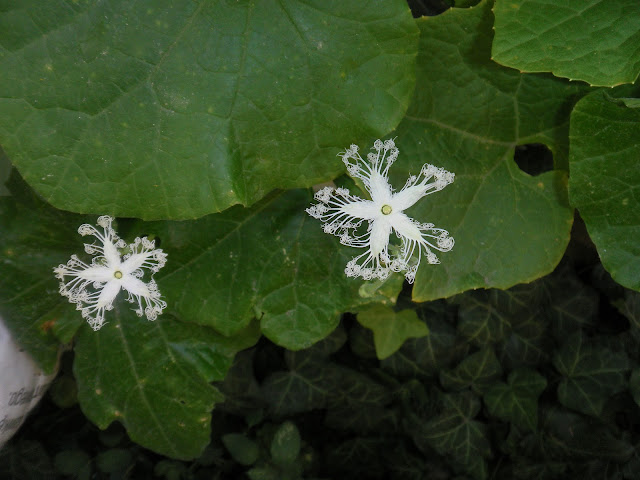Snake Gourd, Snake Tomato (Trichosanthes anguina, syn.
T. cucumerina var. anguina ) this
is a creeper which belongs to the cucurbit family (Cucurbitaceae).
It grows to about 3m (= 10ft) tall and creates
beautiful jagged white flowers and unusual long - up to 2 m (= 6,5ft) in some
varieties - red fruit resembling a snake (hence the name "snake
gourd"). The wild forms of this species originate from the regions of
south-east Asia, Australia and Oceania. It was domesticated probably in India.
It is cultivated mainly in Africa and southern Asia. The wild subspecies
has small, ovate, bitter fruits. The immature fruits of cultivated varieties
are very delicious when cooked (they have taste similar to green bean pods) and
a pulp of ripe fruit is used like tomato puree (hence probably another English
name "snake tomato") but it is less valued than tomatoes. The cooked
leaves are said to be also edible but be careful (maybe they should be boiled
in a few times changed water?). The fragrant flowers are small but very ornamental.
It is also used as a medicinal plant - the juice of raw leaves is vomiting and
the seeds are used against worms.
Cultivation: the Snake Gourd is not difficult to grow,
but needs long growing period. In north temperate areas it needs to be grown
(started) from potted seedlings planted to direct place after last frosts (its
seeds don't want germinate if sown direct to the ground outside - I think it's
too cold in spring here). Later it is rather easy. As squashes it needs fertile
soil and medium moisture. The varieties have different needs about growing
period - some are earlier and better for growing in temperate areas. In my
experience earlier was “short fruit” Thai variety (with thick, short fruits -
about 25cm/10inch long and very shallowly lobed leaves) and later was “long
fruit” Indonesian variety (with narrow fruits about 50-60cm/2ft long and deeply
lobed leaves). The green fruits and seeds can ripe after harvesting on window
sill but only if they are old enough – more than half-ripe (in my experience
"short fruit" earlier variety - ripened, but "long fruit" later
one - not).
Indonesian "long fruit" variety
It had deeply lobed leaves
Fruits were very long and narrow, late
I harvested only 2 immature fruits of this variety and they have not ripened after harvest
TheThai "short fruit" variety
It had shallowly lobed leaves
This variety was early (it was in flowers as early as in first half of August)
And short, thick fruits
The fruits ripened after harvest
The red flesh covered each seed. Mature fruits are very soft
























